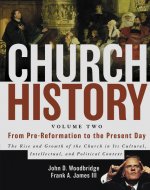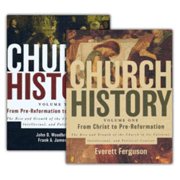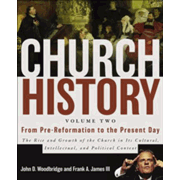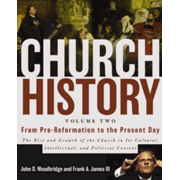Zondervan’s Church History, Volume Two, From Pre-Reformation to the Present Day ranks at the top my list of church histories. This 2013 publication by John D. Woodbridge and Frank A. James III is a hefty 862 pages in length and is intended primarily for use in colleges and seminaries. However, it is also one of the most readable and fascinating presentations of church history, and it should appeal to anyone with an interest in the subject. There are four reasons for my high praise for this volume: breadth of context, the inclusion of all (or at least the most important) strands of Christianity, engaging style of writing, and up-to-date content.
The book is subtitled, “The Rise and Growth of the Church in Its Cultural, Intellectual, and Political Context.” The context is the foremost of the four reasons I think so highly of this book. Yes, it takes longer to read, but the context provides the backdrop of historical, cultural, intellectual, and political events as well as the backstories of key players so that we are given a much fuller framework within which to study events within the church. For example, in my opinion, this book has one of the best presentations regarding the political motivations that contributed to and helped advance the Protestant Reformation. While the authors are both Protestant—Woodbridge is a professor at Trinity Evangelical Divinity School in Deerfield, Illinois and James is the president of Biblical Seminary in Hatfield, Pennsylvania—they don’t shy away from the history of Protestant infighting such as happened immediately after the Reformation and other controversial developments up through the “emerging church” movement with its rejection of ties to denominations and doctrines.
Secondly, the inclusion of Orthodoxy and Catholicism is refreshing. While the authors retain a Protestant outlook, their treatment of Orthodoxy and Catholicism is honest and accurate, giving praise where it is due. For example, in a brief section regarding Cardinal John Henry Newman, the Anglican priest and theologian who converted to Catholicism in 1845, the authors discuss one of Newman’s most important works, An Essay on the Development of Christian Doctrine, even though the conclusions of that book would be rejected by many Protestants. This sort of treatment of church history can do much to heal the barriers between Christian brethren across the spectrum. Another positive side note along this line. is the rather extensive inclusion of Islam. This treatment is important since conflicts between Christianity and Islam have played such a major role in history from the inception of Islam through the present day.
Thirdly, the lively writing style makes this book much more of a page-turner, unlike most church histories. I think that the inclusion of so much context makes the history read like a story. As the pieces of the puzzle come together, it makes me want to read what happens next. Even though I’ve read a great deal of church history, I was still frequently surprised because the context puts a different spin on things, presenting new ways to assimilate what I think I know.
My fourth point needs no elaboration since coverage of new developments is always welcome.
The size of this book might be a deterrent to some readers, but it is well worth investing the time for as long as it takes. It will definitely broaden your knowledge and understanding.
The book is available in hardcover, as an ebook directly from the publisher, and as a Kindle book from Amazon.














